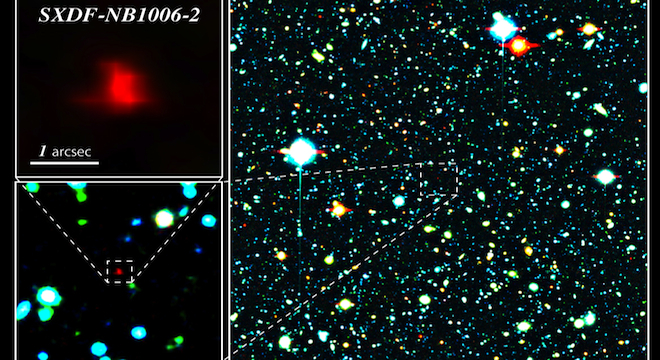In the galactic equivalent of a massive paparazzi scoop, Japanese researchers in early June obtained an image of what they believe to be the furthest and consequently most ancient galaxy yet spotted by humankind, using two telescopes in Hawaii.
The galaxy’s name, the SXDF-NB1006-2, is a mouthful, but it is unquestionably an old and far away galaxy, at 12.91 billion light years from Earth near the constellation Cetus.
Further, it could shine light on the conditions of the universe shortly after the Big Bang, the enormous, sudden expansion of matter that is thought to have given birth to the universe some 13.7 billion years ago.
Already, scientists know just from their one blurry image of the galaxy that the universe some 12.91 billion years ago likely contained much more neutral hydrogen gas.
“I was more relieved than surprised,” at the finding of the galaxy, said Takatoshi Shibuya, an astronomer at the Graduate University for Advanced Studies, in email to TPM.
That’s because Takatoshi and colleagues were essentially looking for a needle in a haystack, finding the galaxy after surveying some 58,733 objects in the night sky. The survey was conducted over 7 nights, totaling 37 hours, using a custom filter on Hawaii’s Subaru telescope, located near the summit of the Mauna Kea volcano on the Big Island.
The filter itself allowed the research team to narrow in on galaxies in a certain wavelength of light called redshift 7.3. Four galaxy candidates were located in this redshift, but the team then narrowed those down to two.
“This is because the light from distant sources is shifted to the red of the spectrum,” Shibuya explained to TPM.
Subaru’s telescopic counterpart, Keck, located just a few feet away on Mauna Kea, was then used to confirm that of the two remaining potential early galaxies, only one, SXDF-NB1006-2, was an actual galaxy. But the team is highly confident of its findings now.
“I could not help but feel anxious about its authenticity until we could get their spectrum,” Shibuya said. “We were glad that our effort has been rewarded.”
Indeed, although the newly-discovered old galaxy doesn’t seem to be as far away or as old as other discoveries previously reported by astronomers using other telescopes — including a galaxy said to be 13.2 billion light years found in 2011 using the Hubble Space Telescope and a galaxy said to be 13.1 billion light years away found in 2011 using a Chilean ground telescope — the Japanese team’s finding is the furthest and oldest one that’s been definitively confirmed, as Shibuya explained to TPM.
“The galaxy discovered by the [Hubble] in 2011 was selected out by the color estimation,” Shibuya wrote. “Therefore, we don’t know whether it’s a real distant galaxy until spectroscopic observations are carried out. In addition, we don’t know the accurate distance from the Earth.”
But the Japanese researchers were able to find their galaxy’s emission line — a trace of hot gas being released by the galaxy over time. Check out the following emissions lines in a diagram below:

Unfortunately, the researchers still don’t know what shape the old galaxy takes — whether its a spiral like the Milky Way or elliptical or irregular.
Still, between the Japanese team’s galaxy finding and two other early universe modeling efforts — NASA’s recent discovery of the faint glow of early stars and a new 3D simulation of the location of those stars created by Israeli and U.S. scientists — images of the entire cosmos in its youth are rapidly coming into focus.






